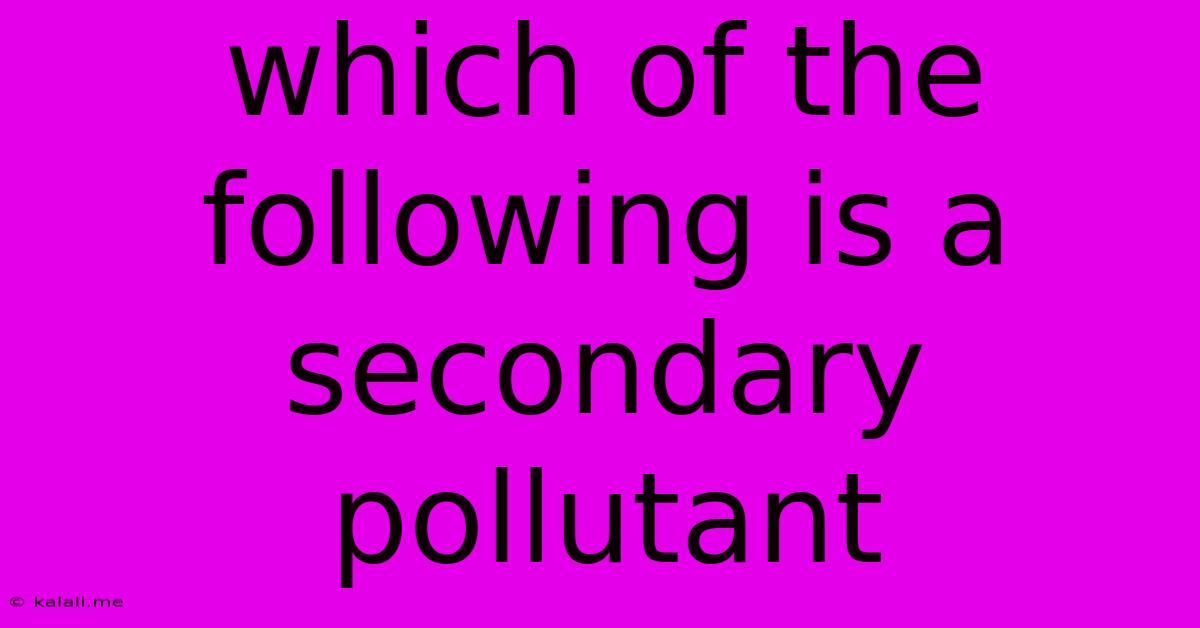Which Of The Following Is A Secondary Pollutant
Kalali
Jun 13, 2025 · 3 min read

Table of Contents
Which of the Following is a Secondary Pollutant? Understanding Air Pollution
Air pollution is a significant environmental concern, impacting human health and the planet's ecosystems. Understanding the different types of pollutants is crucial to addressing this issue effectively. This article dives into the classification of pollutants, specifically focusing on secondary pollutants, and providing examples to help you grasp the concept. We'll explore what differentiates primary and secondary pollutants and highlight some common examples of secondary pollutants.
What are Primary and Secondary Pollutants?
Air pollutants are broadly categorized into two groups: primary and secondary. Primary pollutants are those emitted directly from a source, such as a vehicle exhaust pipe or a factory smokestack. These are substances released directly into the atmosphere in a harmful form. Examples include carbon monoxide (CO), sulfur dioxide (SO2), nitrogen oxides (NOx), particulate matter (PM), and volatile organic compounds (VOCs).
Secondary pollutants, on the other hand, are not emitted directly. They are formed when primary pollutants react in the atmosphere. This chemical transformation often involves sunlight (photochemical reactions) and can lead to the creation of new and even more harmful pollutants. This is a key distinction: the harmful substance is created in the atmosphere, not directly released.
Examples of Secondary Pollutants:
Several pollutants fall into the secondary pollutant category. Some of the most significant include:
-
Ozone (O3): Ground-level ozone is a major component of smog and is formed through a complex series of reactions involving NOx and VOCs in the presence of sunlight. While ozone in the stratosphere protects us from harmful UV radiation, ground-level ozone is a respiratory irritant and can cause serious health problems.
-
Sulfuric Acid (H2SO4): This strong acid is formed when sulfur dioxide (SO2), a primary pollutant, reacts with water vapor and oxygen in the atmosphere. Sulfuric acid contributes significantly to acid rain, damaging ecosystems and infrastructure.
-
Nitric Acid (HNO3): Similar to sulfuric acid, nitric acid is a secondary pollutant formed from the reaction of nitrogen oxides (NOx) with water vapor and oxygen in the atmosphere. It also contributes to acid rain and respiratory problems.
-
Peroxyacetyl nitrate (PAN): PAN is a powerful eye and respiratory irritant formed from the photochemical reactions of NOx and VOCs. It's a major component of photochemical smog.
-
Secondary Particulate Matter: While some particulate matter is emitted directly (primary PM), other particles are formed through atmospheric chemical reactions. These secondary PM particles can be even more harmful than primary PM due to their smaller size and ability to penetrate deeper into the lungs.
Identifying Secondary Pollutants in a Multiple Choice Question:
When faced with a multiple-choice question asking to identify a secondary pollutant, remember the key characteristic: it's not directly emitted but rather formed through atmospheric reactions. Look for pollutants formed from the interaction of primary pollutants and atmospheric conditions. For example, if you see options like carbon monoxide, sulfur dioxide, and ozone, the ozone would be the secondary pollutant.
Understanding the difference between primary and secondary pollutants is essential for developing effective strategies for air quality management and improving public health. By controlling the emissions of primary pollutants, we can significantly reduce the formation of secondary pollutants and improve air quality. Focusing on emission reduction strategies for vehicles, industries, and other sources of primary pollution is crucial in mitigating the broader issue of air pollution.
Latest Posts
Latest Posts
-
How To Calculate The Bandwidth Of A Signal
Jun 14, 2025
-
Which Of The Following Is Misspelled
Jun 14, 2025
-
The Sum Of Two Irrational Numbers Is Irrational
Jun 14, 2025
-
How Many Electron Shells Does Potassium Have
Jun 14, 2025
-
Is The Process That Destroys All Microbial Life Including Spores
Jun 14, 2025
Related Post
Thank you for visiting our website which covers about Which Of The Following Is A Secondary Pollutant . We hope the information provided has been useful to you. Feel free to contact us if you have any questions or need further assistance. See you next time and don't miss to bookmark.